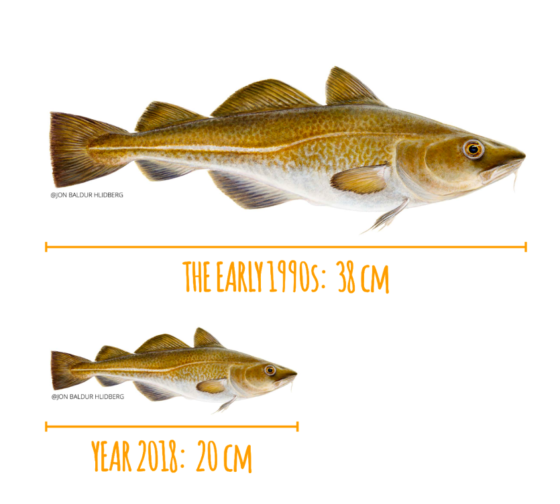Baltic cod
The collapse of Baltic cod

Copyright: Eero Aro
A Baltic catch in 1987. The photo above was taken in March 1987 during a three week research expedition in the Baltic, carried out by the Danish research vessel R/V DANA. One of the researchers on board was Ph.D. Eero Aro – the man you see in the photo hugging a 22 kg large female cod caught in the Southern part of the Baltic in the Polish fishing grounds Slupsk Furrow.
“Our total catch of Baltic cod as displayed in this photo was around 7000 kg caught in just 20 minutes and counted more than 100 individuals of 20 kg or above. This lady in my arms weighted 22 kg. The even bigger lady in the foreground of the photo had a total weight of 36 kg”, explains Eero Aro, who is now retired.
In contrast, during 2016-2019, other researchers tagged 20 000 Baltic cod in Swedish, Danish, German and Polish waters to learn more about their growth and mortality. In 2016 and 2017 the researchers found almost no cod larger than 50 cm.
The shrinking Baltic Cod

Two distinct stocks of cod exist in the Baltic Sea – the western and the eastern. Cod was a high value fish for fishermen as well as consumers. However, the Baltic cod is in serious trouble. Especially the eastern Baltic stock has suffered an alarming decrease of it’s size at first maturation and growth, which has reduced the commercial value drastically.
Research shows the size-at-maturity has substantially declined from the 1990s to 2000s. The so-called L50 value, where 50 percent of the stock is mature and contributes to spawning, was estimated at around 35–40 cm in the early 1990s but has declined to around 20 cm since late 2000s or the last 10 years. These cod tend to stay small for the rest of their lives, resulting in them laying fewer eggs and giving us smaller fillets.
Scientists does not know exactly why the eastern Baltic cod has shrunk, but theories include:
- Lack of food – the cod is starving
- High fishing pressure – causing the cod to adapt genetically
- Eutrophication and dead sea beds – limiting the living space for cod
- Parasites spread by seals infecting the cod
The TABACOD tagging program and research project concluded that eastern Baltic cod had a peak in growth in the 1980s (~11 cm/y for a 35-cm fish) followed by a drop; the current growth of eastern Baltic cod is the lowest (~6 cm/y for a 35-cm fish) ever recorded since the 1950s, and significantly lower than the growth of the neighboring western Baltic cod (~14.5 cm/y for a 35-cm fish).
Large-sized cod at a historic low in the Baltic Sea
Large cod have never been so scarce in the Baltic Sea as they are today, a study shows. If this is a sign of genetic change, we may be left with an ecosystem where large predatory fish have disappeared.

Source: Baltic Eye
Öresund and Sea of Åland – positive exceptions
Despite the generally poor growth of the Baltic cod, and despite the skewed size composition, there are still positive exceptions. In Öresund (The Sound), where a trawling ban has been in place since the 1930s, the stock has a normal size distribution, and above all there are more large individuals (around 50 centimetres).
The cod in the Sea of Åland is another positive example. In contrast to the eastern Baltic cod living in the southern Baltic Sea the cod in the Sea of Åland still grows big. A hypothesis is that cod in this area have developed an ability to spawn successfully in water with lower salinity. Previous research has shown that Sea of Åland cod may be genetically separated from eastern Baltic cod. A new study will investigate if part of the population is able to spawn in water with less salt. If this proves true, it can provide a lifeline for the collapsed Baltic cod stocks since the Baltic Sea is predicted to become less salty in the future.
Last updated: March 19, 2021